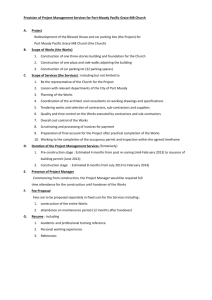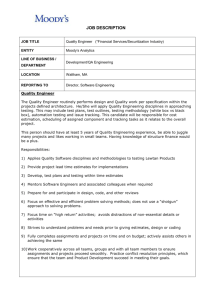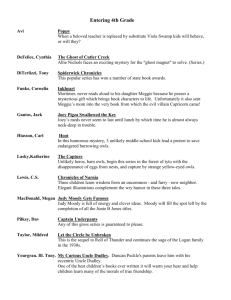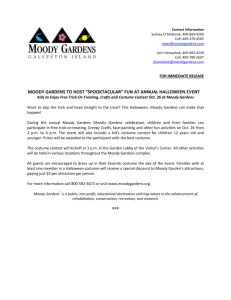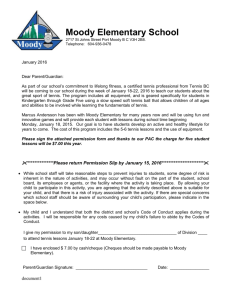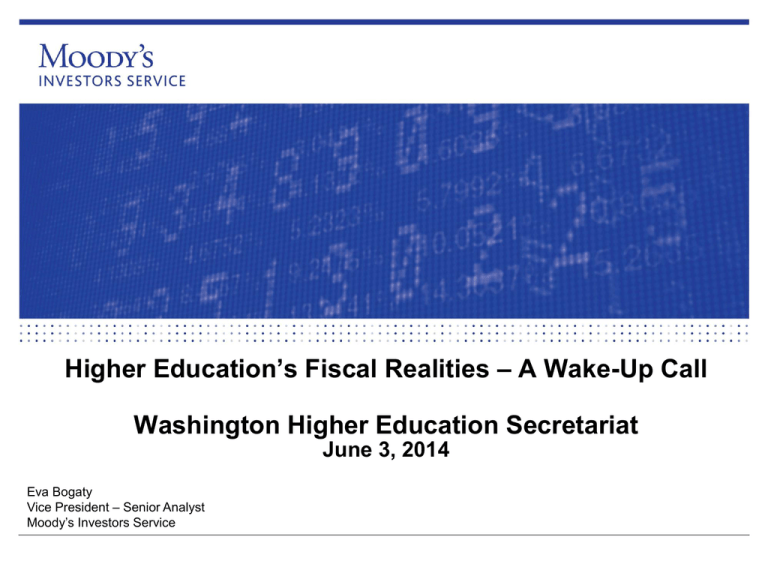
Higher Education’s Fiscal Realities – A Wake-Up Call
Washington Higher Education Secretariat
June 3, 2014
Eva Bogaty
Vice President – Senior Analyst
Moody’s Investors Service
Global Higher Education & Not-For-Profit Team Ratings
» Over 230 public universities, with nearly $120 billion of outstanding debt
» Median rating of A1 by number of institutions, Aa2 weighted by rated debt
» More than 280 private colleges and universities, with nearly $85 billion of outstanding debt
» Median rating of A2 by number of institutions, Aa2 weighted by rated debt
» Around 20 non-US public universities
» Median rating of Aa2 by number of institutions
» Nearly 70 community colleges with $3.4 billion of revenue-backed debt
» Median rating of A2 by number of institutions, A1 weighted by rated debt
» Tax-backed debt rated by local governments team
» Over 110 not-for-profit institutions, $13.5 billion of rated debt
» Median rating of A1 by number of institutions, median rating of Aa2 weighted by rated debt
» Nearly 40 independent K-12 schools, $1.2 billion of debt
» Median rating of A1 by number of institutions, Aa3 weighted by rated debt
Source: Moody's as of March 31, 2013
WHES June 2014
2
2014 Outlook for US Higher Ed & NFPs Negative
Outlook Horizon: 12-18 months
Key Drivers
1. Slowly growing revenue eclipsed by pressure to increase expenses
2. Heightened competition, including changing delivery and business models
3. Flat to declining governmental funding and apportionment may not be predictable
4. Political scrutiny and increased regulatory oversight add uncertainty
Counterpoints
1. Proven adaptability to weak economic conditions
2. Fundamental demand for higher education is still high
3. Stronger earnings by educational attainment
WHES June 2014
3
Revenue Growth Slows While Expense Pressure Builds
Expense Growth Exceeds Revenue Growth
» Operating margins expected
to contract
» Value of higher education
questioned as student loan
default rates continue to rise
» Investments and philanthropy:
Better returns, but volatile;
increasing global competition
for philanthropy
% of Obligors with Expenses Growing Faster than Revenues
» Continued focus on affordability
will result in weak net tuition
revenue growth
Public
Private
CCD
2009
2010
K12
NFP
70%
60%
50%
40%
30%
20%
10%
0%
2008
2011
2012
Source: Moody's Municipal Financial Ratio Analysis
WHES June 2014
4
Revenue Growth Slows While Expense Pressure Builds
Median Change in Revenues and Expense, All Public Universities
Median Expense Growth Rate
Median Revenue Growth Rate
8%
7%
6%
5%
4%
3%
2%
1%
0%
FY 2004
FY 2005
FY 2006
FY 2007
FY 2008
FY 2009
FY 2010
FY 2011
FY 2012
Est. FY
2013
Source: Moody's Municipal Financial Ratio Analysis
WHES June 2014
5
Revenue Growth Slows While Expense Pressure Builds
Median Change in Revenues and Expense, All Community Colleges
Median Expense Growth Rate
Median Revenue Growth Rate
10%
8%
6%
4%
2%
0%
-2%
FY 2004
FY 2005
FY 2006
FY 2007
FY 2008
FY 2009
FY 2010
FY 2011
FY 2012
Est. FY
2013
Source: Moody's Municipal Financial Ratio Analysis
WHES June 2014
6
Net Tuition Revenue Growth Constrained for Large
Majority
Net tuition revenue declines anticipated in FY 2014
Private Universities
Decline
Growth between 0% and 2%
Public Universities
Growth greater than 2%
Decline
100%
100%
80%
80%
60%
60%
40%
40%
20%
20%
0%
Growth between 0% and 2%
Growth greater than 2%
0%
2004
2005
2006
2007
2008
2009
2010
2011
2012
2013* 2014**
(est.) (proj.)
2004
2005
2006
2007
2008
2009
2010
2011
2012
2013* 2014**
(est.) (proj.)
Note: FY 2004 to FY 2012 data are actuals. *FY 2013 estimated; **FY 2014 projected
Source: Moody's Municipal Financial Ratio Analysis (FY 2004 - FY 2012); Moody's 2013 Tuition Survey (FY 2013 - FY 2014)
WHES June 2014
7
Focus on Governance & Management to Provide LongTerm Sustainability
Quest for Cost Efficiency in Light of Decelerating Revenues
% public universities cutting expenses
% private universities cutting expenses
% public universities with declining revenue
% private universities with declining revenue
35%
30%
% of universities
25%
20%
15%
10%
5%
0%
2005
2006
2007
2008
2009
2010
2011
2012
Est. 2013
Source: Moody's Municipal Financial Ratio Analysis
WHES June 2014
8
Weakening Demographics Impact Enrollment
Projected High School Graduates (Base period: 2002 = 100)
South
West
Northeast
Midwest
130
125
120
115
110
105
100
95
90
Source: WICHE, Moody's Economy.com
WHES June 2014
9
Changing Business Models Increase Competition
» Gradually moving away
from one-site in-person
model
» Greater flexibility is
beneficial for students but
adds complexity to the
landscape
Technology
Portability
Credentialing
Evolution
of Higher
Education
» Will always likely be
demand for the traditional
model with technology
complementing the
classroom experience
Partnering
Competency
Based
Learning
WHES June 2014
10
Barbell Enrollment Growth Projected: Grad and Associate
Competition remains strong at undergraduate level
Associates
Bachelors
Masters
260
240
Indexed Growth of
Degrees Conferred
220
200
180
160
140
120
100
Projection
Academic Year
Source: US Department of Education
WHES June 2014
11
Increased Interest in Online Learning; New Market Players
» First free online university receives accreditation in February 2014
» Online education platform, 2U, goes public
» Google offers MOOC
Source: Babson Survey Research Group, Sloan Consortium - Grade Change: Tracking Online Education in the United States, January 2014
WHES June 2014
12
Increasingly competitive market for international students
Distribution of Foreign Students
2011
Market Share is Changing
(% of transnational enrollment)
4.3 Million
Students
Worldwide
2000
2011
35%
Other non
OECD
Countries,
22.90%
United States,
16.50%
30%
25%
United
Kingdom, 13%
20%
15%
Other OECD
Countries,
28.90%
Germany,
6.30%
10%
5%
France, 6.20%
Australia,
6.10%
0%
United
States
United Germany France Australia
Kingdon
Other Other non
OECD
OECD
Countries Countries
Source: Education at a Glance 2013, OECD Indicators and Australian Education International
WHES June 2014
13
Changes in Federal Funding Would Have a Major Impact
Major Aid Programs for Undergraduate Students (Aggregate Spending)
Data presented in constant 2012 dollars ($ millions)
2006-2007
2008-2009
2011-2012
Federal Stafford Loans
$55,573
$76,505
$89,607
Federal Pell Grants
$14,430
$19,051
$34,048
Federal Parent Loans for Undergraduate Students (PLUS)
$11,507
$12,514
$18,931
Federal tax benefits
$7,410
$11,160
$20,280
Federal veterans grants
$3,710
$4,358
$11,007
State grants
$8,535
$8,749
$9,532
Institutional grants
$29,510
$32,310
$42,650
State and Institution loans
$2,360
$1,660
$1,690
Private student loans
$21,390
$10,730
$6,440
Source: College Board, Trends in Student Aid 2013
WHES June 2014
14
Federally Sponsored Research Stagnating After Years of
Strong Growth
Federally Funded R&D
ARRA
Budget cut under sequestration
70
60
($) billions
50
40
30
20
10
0
Source: National Science Foundation
2014 is Moody's Estimate
Note: ARRA =American Recovery and Reinvestment Act of 2009
WHES June 2014
15
States cautiously optimistic after years of fiscal stress
»
States face opportunities and risks as the US economy recovers
–
»
The recovery continues, but labor market conditions remain tepid
After years of austerity, states anticipate enough revenue to restore some funding
–
»
Reduced incidence of mid-year spending cuts
In state-of-the-state addresses this year, governors presented plans to:
–
Increase education funding
–
Invest in infrastructure
–
Cut taxes
»
Improved tax revenue always tends to spur pressure for increased funding
»
This time, states are generally cautious
–
Not proposing multi-year spending initiatives
–
Only restoring funding in core areas such as education
»
Few are prioritizing rebuilding financial reserves
»
For some, tax cuts implemented now may point to fiscal challenges later
WHES June 2014
16
Increased State Funding, Often With Limits on Tuition
» Wide disparity in funding levels from state to state
» States have multiple funding priorities, higher education funding unlikely to be robust in the
foreseeable future
» Overall revenue growth constrained due to tuition limits, regional publics most affected
FY2014 Funding Up in Many States
Funding Still Below Levels Five Years Ago
% increase from 2013
% increase 2009-2014
30%
80%
25%
60%
20%
40%
15%
10%
20%
5%
0%
0%
-20%
-5%
-10%
-40%
0
10
20
30
40
50
0
10
20
30
40
50
Source: Illinois State University-Grapevine Data
WHES June 2014
17
Unfunded pension liabilities vary widely, with worst
burdens concentrated in a few states
Highest and lowest state pension liabilities
Based on three-year average ANPL to 2012 Governmental Revenues
Illinois
258.4%
Connecticut
201.2%
Kentucky
170.4%
Hawaii
155.4%
Louisiana
153.7%
0.0%
Iowa
20.9%
Tennessee
19.8%
New York
Wisconsin
Nebraska
0.0%
50.0%
100.0%
150.0%
200.0%
250.0%
300.0%
50.0%
100.0%
150.0%
200.0%
250.0%
300.0%
16.1%
11.0%
8.8%
WHES June 2014
18
Efficiency Efforts & Partnerships Pursued
» Shared services pursued by large, research intensive universities with
economies of scale (University of Michigan, Yale University, University of
California- Berkley)
» Consortia to create purchasing power (insurance, supplies, etc.)
» Programmatic partners to leverage academic strengths and focus scarce
resources on areas of distinction
» Co-location to cater to key source of students (community college and regional
public university, community college and military base, etc.)
» Privatized student housing gaining in scale and piquing private university
interest
WHES June 2014
19
Susan Fitzgerald
Senior Vice President
Higher Education & Not-for-Profit Team
Susan.Fitzgerald@moodys.com
Kendra Smith
Managing Director
Health Care, Higher Education & Housing Teams
Kendra.Smith@moodys.com
Edie Behr
Vice President/Sr. Credit Officer
Higher Education & Not-for-Profit Team
Edith.behr@moodys.com
Karen Kedem
Vice President-Senior Analyst
Higher Education & Not-for-Profit Team
Karen.Kedem@moodys.com
Eva Bogaty
Vice President-Senior Analyst
Higher Education & Not-for-Profit Team
Eva.Bogaty@moodys.com
WHES June 2014
20
© 2014 Moody’s Corporation, Moody’s Investors Service, Inc., Moody’s Analytics, Inc. and/or their
licensors and affiliates (collectively, “MOODY’S”). All rights reserved.
CREDIT RATINGS ISSUED BY MOODY'S INVESTORS SERVICE, INC. (“MIS”) AND ITS
AFFILIATES ARE MOODY’S CURRENT OPINIONS OF THE RELATIVE FUTURE CREDIT RISK OF
ENTITIES, CREDIT COMMITMENTS, OR DEBT OR DEBT-LIKE SECURITIES, AND CREDIT
RATINGS AND RESEARCH PUBLICATIONS PUBLISHED BY MOODY’S (“MOODY’S
PUBLICATIONS”) MAY INCLUDE MOODY’S CURRENT OPINIONS OF THE RELATIVE FUTURE
CREDIT RISK OF ENTITIES, CREDIT COMMITMENTS, OR DEBT OR DEBT-LIKE SECURITIES.
MOODY’S DEFINES CREDIT RISK AS THE RISK THAT AN ENTITY MAY NOT MEET ITS
CONTRACTUAL, FINANCIAL OBLIGATIONS AS THEY COME DUE AND ANY ESTIMATED
FINANCIAL LOSS IN THE EVENT OF DEFAULT. CREDIT RATINGS DO NOT ADDRESS ANY
OTHER RISK, INCLUDING BUT NOT LIMITED TO: LIQUIDITY RISK, MARKET VALUE RISK, OR
PRICE VOLATILITY. CREDIT RATINGS AND MOODY’S OPINIONS INCLUDED IN MOODY’S
PUBLICATIONS ARE NOT STATEMENTS OF CURRENT OR HISTORICAL FACT. MOODY’S
PUBLICATIONS MAY ALSO INCLUDE QUANTITATIVE MODEL-BASED ESTIMATES OF CREDIT
RISK AND RELATED OPINIONS OR COMMENTARY PUBLISHED BY MOODY’S ANALYTICS, INC.
CREDIT RATINGS AND MOODY’S PUBLICATIONS DO NOT CONSTITUTE OR PROVIDE
INVESTMENT OR FINANCIAL ADVICE, AND CREDIT RATINGS AND MOODY’S PUBLICATIONS
ARE NOT AND DO NOT PROVIDE RECOMMENDATIONS TO PURCHASE, SELL, OR HOLD
PARTICULAR SECURITIES. NEITHER CREDIT RATINGS NOR MOODY’S PUBLICATIONS
COMMENT ON THE SUITABILITY OF AN INVESTMENT FOR ANY PARTICULAR INVESTOR.
MOODY’S ISSUES ITS CREDIT RATINGS AND PUBLISHES MOODY’S PUBLICATIONS WITH THE
EXPECTATION AND UNDERSTANDING THAT EACH INVESTOR WILL, WITH DUE CARE, MAKE
ITS OWN STUDY AND EVALUATION OF EACH SECURITY THAT IS UNDER CONSIDERATION
FOR PURCHASE, HOLDING, OR SALE.
MOODY’S CREDIT RATINGS AND MOODY’S PUBLICATIONS ARE NOT INTENDED FOR USE BY
RETAIL INVESTORS AND IT WOULD BE RECKLESS FOR RETAIL INVESTORS TO CONSIDER
MOODY’S CREDIT RATINGS OR MOODY’S PUBLICATIONS IN MAKING ANY INVESTMENT
DECISION. IF IN DOUBT YOU SHOULD CONTACT YOUR FINANCIAL OR OTHER
PROFESSIONAL ADVISER.
ALL INFORMATION CONTAINED HEREIN IS PROTECTED BY LAW, INCLUDING BUT NOT
LIMITED TO, COPYRIGHT LAW, AND NONE OF SUCH INFORMATION MAY BE COPIED OR
OTHERWISE REPRODUCED, REPACKAGED, FURTHER TRANSMITTED, TRANSFERRED,
DISSEMINATED, REDISTRIBUTED OR RESOLD, OR STORED FOR SUBSEQUENT USE FOR
ANY SUCH PURPOSE, IN WHOLE OR IN PART, IN ANY FORM OR MANNER OR BY ANY MEANS
WHATSOEVER, BY ANY PERSON WITHOUT MOODY’S PRIOR WRITTEN CONSENT.
All information contained herein is obtained by MOODY’S from sources believed by it to be accurate
and reliable. Because of the possibility of human or mechanical error as well as other factors,
however, all information contained herein is provided “AS IS” without warranty of any kind. MOODY'S
adopts all necessary measures so that the information it uses in assigning a credit rating is of
sufficient quality and from sources MOODY'S considers to be reliable including, when appropriate,
independent third-party sources. However, MOODY’S is not an auditor and cannot in every instance
independently verify or validate information received in the rating process or in preparing the Moody’s
Publications.
To the extent permitted by law, MOODY’S and its directors, officers, employees, agents,
representatives, licensors and suppliers disclaim liability to any person or entity for any indirect,
special, consequential, or incidental losses or damages whatsoever arising from or in connection with
the information contained herein or the use of or inability to use any such information, even if
MOODY’S or any of its directors, officers, employees, agents, representatives, licensors or suppliers
is advised in advance of the possibility of such losses or damages, including but not limited to: (a) any
loss of present or prospective profits or (b) any loss or damage arising where the relevant financial
instrument is not the subject of a particular credit rating assigned by MOODY’S.
To the extent permitted by law, MOODY’S and its directors, officers, employees, agents,
representatives, licensors and suppliers disclaim liability for any direct or compensatory losses or
damages caused to any person or entity, including but not limited to by any negligence (but excluding
fraud, willful misconduct or any other type of liability that, for the avoidance of doubt, by law cannot be
excluded) on the part of, or any contingency within or beyond the control of, MOODY’S or any of its
directors, officers, employees, agents, representatives, licensors or suppliers, arising from or in
connection with the information contained herein or the use of or inability to use any such information.
NO WARRANTY, EXPRESS OR IMPLIED, AS TO THE ACCURACY, TIMELINESS,
COMPLETENESS, MERCHANTABILITY OR FITNESS FOR ANY PARTICULAR PURPOSE OF ANY
SUCH RATING OR OTHER OPINION OR INFORMATION IS GIVEN OR MADE BY MOODY’S IN
ANY FORM OR MANNER WHATSOEVER.
MIS, a wholly-owned credit rating agency subsidiary of Moody’s Corporation (“MCO”), hereby
discloses that most issuers of debt securities (including corporate and municipal bonds, debentures,
notes and commercial paper) and preferred stock rated by MIS have, prior to assignment of any
rating, agreed to pay to MIS for appraisal and rating services rendered by it fees ranging from $1,500
to approximately $2,500,000. MCO and MIS also maintain policies and procedures to address the
independence of MIS’s ratings and rating processes. Information regarding certain affiliations that
may exist between directors of MCO and rated entities, and between entities who hold ratings from
MIS and have also publicly reported to the SEC an ownership interest in MCO of more than 5%, is
posted annually at www.moodys.com under the heading “Shareholder Relations — Corporate
Governance — Director and Shareholder Affiliation Policy.”
For Australia only: Any publication into Australia of this document is pursuant to the Australian
Financial Services License of MOODY’S affiliate, Moody’s Investors Service Pty Limited ABN 61 003
399 657AFSL 336969 and/or Moody’s Analytics Australia Pty Ltd ABN 94 105 136 972 AFSL 383569
(as applicable). This document is intended to be provided only to “wholesale clients” within the
meaning of section 761G of the Corporations Act 2001. By continuing to access this document from
within Australia, you represent to MOODY’S that you are, or are accessing the document as a
representative of, a “wholesale client” and that neither you nor the entity you represent will directly or
indirectly disseminate this document or its contents to “retail clients” within the meaning of section
761G of the Corporations Act 2001. MOODY’S credit rating is an opinion as to the creditworthiness of
a debt obligation of the issuer, not on the equity securities of the issuer or any form of security that is
available to retail clients. It would be dangerous for “retail clients” to make any investment decision
based on MOODY’S credit rating. If in doubt you should contact your financial or other professional
adviser.
WHES June 2014
21

